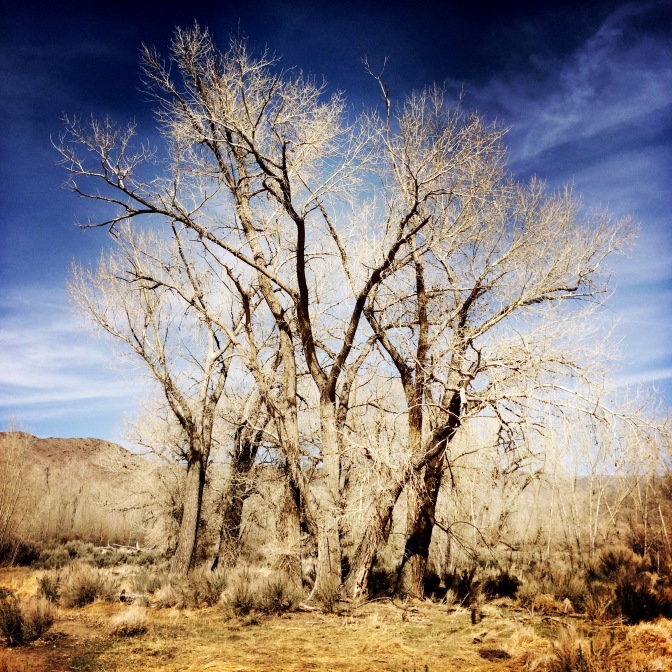
Renee and I went out east on the Truckee River and helped out on The Nature of Art yesterday. It’s a blend between a piece of art and a site for habitat restoration. The artists, Daniel McCormick and Mary O’Brien, were great people and knowledgeable and it was a treat to spend time with them. We learned to make willow wattles (bundles of willow that are the sculpture’s body) and planted some willows along its base. The sculpture itself was a long wave that reflected for me the shape of a fallen tree, the effect enhanced by a cottonwood skeleton at its head that the artists hope will one day attract nesting birds. It also will slow down water and eventually return to itself through the willows. Next we visited another sculpture-in-progress, this one an upside down y-shaped structure composed mostly of old dry cottonwood that extends down a bank and has log arms extending into the water. It will provide habitat for critters and then willows and there was scat showing that western pond turtles have been using it already.

Afterward, never having visited it before, Renee and I walked part of the trail running through the rest of the Nature Conservancy’s McCarran Ranch Preserve, a stretch of the river from near Tracy on the east to near Mustang in the west. It winds along the river and the restoration is pretty amazing given the descriptions that our host recounted from the beginning of the project. He said that when they began it was nothing but abandoned fields, leveled, overgrown in thick mats of tall white top. Now, under the occasional shade of still leafless giant cottonwoods we hiked through deep sagebrush and willow patches and passed a fair number of users, mostly fishers and bicyclists. One guy was fly fishing in the middle of the river with his very happy dog swimming alongside.
As part of research for another post I’ve been introduced to a bit of Washo vocabulary lately. Walking along the river, among so many remains of humanity’s continued reliance on this area as a route and a resource, I envisioned its human history: when the Washo were the main people along its banks, through emigrants and gold/silver seekers, to Wal-mart trucks and Tesla. I’d learned the name that was given to it by its most recent users (us)—the Truckee—but what about those who were here before, the Washo? (The names given to it by other earlier users are disappeared, dispersed forever.) I found the first, most likely version, dabayóduweʔ [Note: symbol at end is not a question mark, but a symbol representing a glottal stop] at the University of Chicago’s Washo project website via Wikipedia. I have also found another possibility, wahku wa’t’a, at the Truckee Donner Historical Society, Inc. site’s Chief Truckee page, but doesn’t seem as authoritative although that site had very interesting accounts of the naming of the Truckee, the most literary being that tro-kay is a Paiute word for “all right” that, when the tribal leader who became known as Truckee said it and then turned out to be right about sweet water to be found at dabayóduweʔ, it became what the newcomers called him and he took to it as a name. These tiny pinpricks of investigation send the feelers for more writing, more exploring.


Nature and art and the names of places, watching birds and cutting willows to make living art. Seeing landscape transform, seeing it cut into the world, the detritus, the memory of humanity’s imprint dumped, piled, leveled everywhere, but underneath, the river channel still leaving a mark. Mary O’Brien told us about a photo that had stuck with her as they planned the project. It was from the early 1990s when the whole area was abandoned and choked by invasive weeds. Below the superficial imprint of “history” the aerial shot showed an outline of the original channel. Like a shadow below, in the same way that dabayóduweʔ is there. The Washoe people have inhabited the Great Basin for 6,000 years, and, while their names are unknown maybe, they still have the power to fire the mind. A great day talking with and helping people who are using creativity, imagination, knowledge and beauty to help the river transform afresh.

Such an awesome project and great day!!!!!!
LikeLike